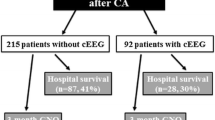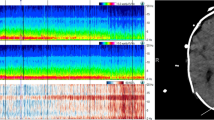Abstract
Electroencephalography in the setting of hypothermia and anoxia has been studied in humans since the 1950s. Specific patterns after cardiac arrest have been associated with prognosis since the 1960s, with several prognostic rating scales developed in the second half of the twentieth century. In 2002, two pivotal clinical trials were published, demonstrating improved neurologic outcomes in patients treated with therapeutic hypothermia (TH) after cardiac arrest of shockable rhythms. In the following years, TH became the standard of care in these patients. During the same time period, the use of continuous EEG monitoring in critically ill patients increased, which led to the recognition of subclinical seizures occurring in patients after cardiac arrest. As a result of these changes, greater amounts of EEG data are being collected, and the significance of specific patterns is being re-explored. We review the current role of EEG for the identification of seizures and the estimation of prognosis after cardiac resuscitation.
Similar content being viewed by others
References
Becker LB, Smith DW, Rhodes KV. Incidence of cardiac arrest: a neglected factor in evaluating survival rates. Ann Emerg Med. 1993;22:86–91.
de Vreede-Swagemakers JJ, Gorgels AP, Dubois-Arbouw WI, et al. Out-of-hospital cardiac arrest in the 1990’s: a population-based study in the Maastricht area on incidence, characteristics and survival. J Am Coll Cardiol. 1997;30:1500–5.
Nichol G, Thomas E, Callaway CW, et al. Regional variation in out-of-hospital cardiac arrest incidence and outcome. JAMA. 2008;300:1423–31.
Fugate JE, Brinjikji W, Mandrekar JN, et al. Post-cardiac arrest mortality is declining: a study of the US National Inpatient Sample 2001 to 2009. Circulation. 2012;126:546–50.
Hockaday JM, Potts F, Epstein E, Bonazzi A, Schwab RS. Electroencephalographic changes in acute cerebral anoxia from cardiac or respiratory arrest. Electroencephalogr Clin Neurophysiol. 1965;18:575–86.
Lemmi H, Hubbert CH, Faris AA. The electroencephalogram after resuscitation of cardiocirculatory arrest. J Neurol Neurosurg Psychiatry. 1973;36:997–1002.
Pampiglione G. Neurophysiological aspects of cerebral ischaemia. Proc R Soc Med. 1960;53:329–32.
Lance JW, Adams RD. The syndrome of intention or action myoclonus as a sequel to hypoxic encephalopathy. Brain. 1963;86:111–36.
Madison D, Niedermeyer E. Epileptic seizures resulting from acute cerebral anoxia. J Neurol Neurosurg Psychiatry. 1970;33:381–6.
Chokroverty S. “Alpha-like” rhythms in electroencephalograms in coma after cariac arrest. Neurology. 1975;25:655–63.
Westmoreland BF, Klass DW, Sharbrough FW, Reagan TJ. Alpha-coma. Electroencephalographic, clinical, pathologic, and etiologic correlations. Arch Neurol. 1975;32:713–8.
Sorensen K, Thomassen A, Wernberg M. Prognostic significance of alpha frequency EEG rhythm in coma after cardiac arrest. J Neurol Neurosurg Psychiatry. 1978;41:840–2.
Pearcy WC, Virtue RW. The electroencephalogram in hypothermia with circulatory arrest. Anesthesiology. 1959;20:341–7.
Harden A, Pampiglione G, Waterston DJ. Circulatory arrest during hypothermia in cardiac surgery: an E.E.G. study in children. Br Med J. 1966;2:1105–8.
Woodhall B, Sealy WC, Hall KD, Floyd WL. Craniotomy under conditions of quinidine-protected cardioplegia and profound hypothermia. Ann Surg. 1960;152:37–44.
Corry JJ, Dhar R, Murphy T, Diringer MN. Hypothermia for refractory status epilepticus. Neurocrit Care. 2008;9:189–97.
FitzGibbon T, Hayward JS, Walker D. EEG and visual evoked potentials of conscious man during moderate hypothermia. Electroencephalogr Clin Neurophysiol. 1984;58:48–54.
Cabral R, Prior PF, Scott DF, Brierley JB. Reversible profound depression of cerebral electrical activity in hyperthermia. Electroencephalogr Clin Neurophysiol. 1977;42:697–701.
Reilly EL, Barlogie B, Seward MA, Corry PM, Rigor B, Yip E. Persistence of EEG activity with prolonged induced hyperthermic fever. Clin Electroencephalogr. 1980;11:22–7.
Lifshitz A, Lopez M, Fiorelli S, Medina E, Osuna G, Halabe J. The electroencephalogram in adult patients with fever. Clin Electroencephalogr. 1987;18:85–8.
De Georgia M, Raad B. Prognosis of coma after cardiac arrest in the era of hypothermia. Continuum (Minneap Minn). 2012;18:515–31.
van den Broek MP, Groenendaal F, Egberts AC, Rademaker CM. Effects of hypothermia on pharmacokinetics and pharmacodynamics: a systematic review of preclinical and clinical studies. Clin Pharmacokinet. 2010;49:277–94.
Hyptohermia after Cardiac Arrest Study Group. Mild therapeutic hypothermia to improve the neurologic outcome after cardiac arrest. N Engl J Med. 2002;346:549–56.
Bernard SA, Gray TW, Buist MD, et al. Treatment of comatose survivors of out-of-hospital cardiac arrest with induced hypothermia. N Engl J Med. 2002;346:557–63.
Kim F, Nichol G, Maynard C, et al. Effect of prehospital induction of mild hypothermia on survival and neurological status among adults with cardiac arrest: a randomized clinical trial. JAMA. 2014;311:45–52.
Nielsen N, Wetterslev J, Cronberg T, et al. Targeted temperature management at 33 degrees C versus 36 degrees C after cardiac arrest. N Engl J Med. 2013;369:2197–206.
Pampiglione G. Electroencephalographic studies after cardiorespiratory resuscitation. Proc R Soc Med. 1962;55:653–7.
Binnie CD, Prior PF, Lloyd DS, Scott DF, Margerison JH. Electroencephalographic prediction of fatal anoxic brain damage after resuscitation from cardiac arrest. Br Med J. 1970;4:265–8.
Synek VM. Value of a revised EEG coma scale for prognosis after cerebral anoxia and diffuse head injury. Clin Electroencephalogr. 1990;21:25–30.
Young GB, Doig G, Ragazzoni A. Anoxic-ischemic encephalopathy: clinical and electrophysiological associations with outcome. Neurocrit Care. 2005;2:159–64.
Wijdicks EF, Hijdra A, Young GB, Bassetti CL, Wiebe S. Practice parameter: prediction of outcome in comatose survivors after cardiopulmonary resuscitation (an evidence-based review): report of the Quality Standards Subcommittee of the American Academy of Neurology. Neurology. 2006;67:203–10.
Kawai M, Thapalia U, Verma A. Outcome from therapeutic hypothermia and EEG. J Clin Neurophysiol. 2011;28:483–8.
Rossetti AO, Urbano LA, Delodder F, Kaplan PW, Oddo M. Prognostic value of continuous EEG monitoring during therapeutic hypothermia after cardiac arrest. Crit Care. 2010;14:R173.
Tsetsou S, Oddo M, Rossetti AO. Clinical outcome after a reactive hypothermic EEG following cardiac arrest. Neurocrit Care. 2013.
Crepeau AZ, Rabinstein AA, Fugate JE, et al. Continuous EEG in therapeutic hypothermia after cardiac arrest: prognostic and clinical value. Neurology. 2013.
Mani R, Schmitt SE, Mazer M, Putt ME, Gaieski DF. The frequency and timing of epileptiform activity on continuous electroencephalogram in comatose post-cardiac arrest syndrome patients treated with therapeutic hypothermia. Resuscitation. 2012;83:840–7.
Brenner RP, Schwartzman RJ, Richey ET. Prognostic significance of episodic low amplitude or relatively isoelectric EEG patterns. Dis Nerv Syst. 1975;36:582–7.
Rae-Grant AD, Strapple C, Barbour PJ. Episodic low-amplitude events: an under-recognized phenomenon in clinical electroencephalography. J Clin Neurophysiol. 1991;8:203–11.
Gerber PA, Chapman KE, Chung SS, et al. Interobserver agreement in the interpretation of EEG patterns in critically ill adults. J Clin Neurophysiol. 2008;25:241–9.
Mani R, Arif H, Hirsch LJ, Gerard EE, Laroche SM. Interrater reliability of ICU EEG research terminology. J Clin Neurophysiol. 2012;29:203–12.
Spitzmiller RE, Phillips T, Meinzen-Derr J, Hoath SB. Amplitude-integrated EEG is useful in predicting neurodevelopmental outcome in full-term infants with hypoxic-ischemic encephalopathy: a meta-analysis. J Child Neurol. 2007;22:1069–78.
Rundgren M, Westhall E, Cronberg T, Rosen I, Friberg H. Continuous amplitude-integrated electroencephalogram predicts outcome in hypothermia-treated cardiac arrest patients. Crit Care Med. 2010;38:1838–44.
Wennervirta JE, Ermes MJ, Tiainen SM, et al. Hypothermia-treated cardiac arrest patients with good neurological outcome differ early in quantitative variables of EEG suppression and epileptiform activity. Crit Care Med. 2009;37:2427–35.
Rabinstein AA, Wijdicks EF. The value of EEG monitoring after cardiac arrest treated with hypothermia. Neurology. 2012;78:774–5.
Rossetti AO. What is the value of hypothermia in acute neurologic diseases and status epilepticus? Epilepsia. 2011;52(Suppl 8):64–6.
Rittenberger JC, Popescu A, Brenner RP, Guyette FX, Callaway CW. Frequency and timing of nonconvulsive status epilepticus in comatose post-cardiac arrest subjects treated with hypothermia. Neurocrit Care. 2012;16:114–22.
Mani R, Schmitt SE, Mazer M, Putt ME, Gaieski DF. The frequency and timing of epileptiform activity on continuous electroencephalogram in comatose post-cardiac arrest syndrome patients treated with therapeutic hypothermia. Resuscitation. 2012.
Knight WA, Hart KW, Adeoye OM, et al. The incidence of seizures in patients undergoing therapeutic hypothermia after resuscitation from cardiac arrest. Epilepsy Res. 2013.
Legriel S, Bruneel F, Sediri H, et al. Early EEG monitoring for detecting postanoxic status epilepticus during therapeutic hypothermia: a pilot study. Neurocrit Care. 2009;11:338–44.
Rossetti AO, Oddo M, Liaudet L, Kaplan PW. Predictors of awakening from postanoxic status epilepticus after therapeutic hypothermia. Neurology. 2009;72:744–9.
Treiman DM, Meyers PD, Walton NY, et al. A comparison of four treatments for generalized convulsive status epilepticus. Veterans Affairs Status Epilepticus Cooperative Study Group. N Engl J Med. 1998;339:792–8.
Towne AR, Waterhouse EJ, Boggs JG, et al. Prevalence of nonconvulsive status epilepticus in comatose patients. Neurology. 2000;54:340–5.
Claassen J, Mayer SA, Kowalski RG, Emerson RG, Hirsch LJ. Detection of electrographic seizures with continuous EEG monitoring in critically ill patients. Neurology. 2004;62:1743–8.
Hovland A, Nielsen EW, Kluver J, Salvesen R. EEG should be performed during induced hypothermia. Resuscitation. 2006;68:143–6.
Peberdy MA, Callaway CW, Neumar RW, et al. Part 9: post-cardiac arrest care: 2010 American Heart Association Guidelines for Cardiopulmonary Resuscitation and Emergency Cardiovascular Care. Circulation. 2010;122:S768–86.
Crepeau AZ, Fugate JE, Mandrekar J, et al. Value analysis of continuous EEG in patients during therapeutic hypothermia after cardiac arrest. Resuscitation. 2014;85:785–9.
Alvarez V, Sierra-Marcos A, Oddo M, Rossetti AO. Yield of intermittent versus continuous EEG in comatose survivors of cardiac arrest treated with hypothermia. Crit Care. 2013;17:R190.
Young GB, Sharpe MD, Savard M, Al Thenayan E, Norton L, Davies-Schinkel C. Seizure detection with a commercially available bedside EEG monitor and the subhairline montage. Neurocrit Care. 2009;11:411–6.
Kolls BJ, Husain AM. Assessment of hairline EEG as a screening tool for nonconvulsive status epilepticus. Epilepsia. 2007;48:959–65.
Rubin MN, Jeffery OJ, Fugate JE, et al. Efficacy of a reduced electroencephalography electrode array for detection of seizures. Neurohospitalist. 2014;4:6–8.
Conflict of interest
Drs. Crepeau, Britton and Fugate have no conflicts of interest.
Author information
Authors and Affiliations
Corresponding author
Rights and permissions
About this article
Cite this article
Crepeau, A.Z., Britton, J.W., Fugate, J.E. et al. Electroencephalography in Survivors of Cardiac Arrest: Comparing Pre- and Post-therapeutic Hypothermia Eras. Neurocrit Care 22, 165–172 (2015). https://doi.org/10.1007/s12028-014-0018-4
Published:
Issue Date:
DOI: https://doi.org/10.1007/s12028-014-0018-4




